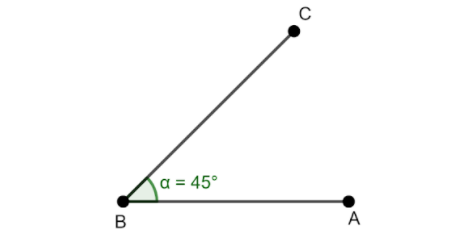
Two line segments with common end points form an _____.
Answer
379.2k+ views
Hint: Here in the question, we have to say which particular geometry of figure(s) the blank space belongs to. So, we recall the definitions of a line, segment, ray, point, etc. Then, we check which of these definitions will fit by constructing (drawing) roughly. Hence, we will get our desired result.
Complete step-by-step answer:
Basically,
In mathematics (geometry), there exist certain geometric constructions which are used to draw mathematical symbols, etc. such as, point, line, segment, ray, angle. So first of all, recall all the definitions keenly.
Point: It is an imaginary point in the space or plane represented by the dot (\[.\]) which does not have length, breadth or height. It is the start of any mathematical/geometrical figure drawn or constructed. Let, we have considered ‘A’ as that distinct point.
Line: Line is the geometry which connects two distinct points which may extend (if in need). Also, it can be shown with the help of arrows at two distinct points. Here, AB is the line represented which can be extended further, either from ‘A’ or from ‘B’ respectively

Segment: It is the representation of line which cannot be extended further i.e. two distinct points are under constraint condition.

Say, ‘AB’ is the segment of the line ‘f’ with the given length or measurement which cannot be extended
Ray: It consists of both the ‘line’ as well as ‘segment’ i.e. one side can be extended (which represents line) ‘B’ and the other side is not extendable (that it shows the segment) at distinct point ‘A’.

Now,
Hence, from the above definition of the segment it seems that (segment is considered because asked in the question),
When two line segments when connected with the single (common) point, then it forms an ‘angle’ at distinct length, as shown below,

Where, ‘CBA’ represents the angle at the distinct point ‘B’ which makes the certain angle alpha ‘\[\alpha \]’ forming with the help of two (line) segments i.e. ‘BA’ and ‘BC’ respectively.
So, the correct answer is “Angle”.
Note: In Euclidean geometry, an angle is the figure formed by two rays, called the sides of the angle, sharing a common endpoint, called the vertex of the angle. Angles formed by two rays lie in the plane that contains the rays. Angles are also formed by the intersection of two planes. These are called dihedral angles.
Complete step-by-step answer:
Basically,
In mathematics (geometry), there exist certain geometric constructions which are used to draw mathematical symbols, etc. such as, point, line, segment, ray, angle. So first of all, recall all the definitions keenly.
Point: It is an imaginary point in the space or plane represented by the dot (\[.\]) which does not have length, breadth or height. It is the start of any mathematical/geometrical figure drawn or constructed. Let, we have considered ‘A’ as that distinct point.
Line: Line is the geometry which connects two distinct points which may extend (if in need). Also, it can be shown with the help of arrows at two distinct points. Here, AB is the line represented which can be extended further, either from ‘A’ or from ‘B’ respectively

Segment: It is the representation of line which cannot be extended further i.e. two distinct points are under constraint condition.

Say, ‘AB’ is the segment of the line ‘f’ with the given length or measurement which cannot be extended
Ray: It consists of both the ‘line’ as well as ‘segment’ i.e. one side can be extended (which represents line) ‘B’ and the other side is not extendable (that it shows the segment) at distinct point ‘A’.

Now,
Hence, from the above definition of the segment it seems that (segment is considered because asked in the question),
When two line segments when connected with the single (common) point, then it forms an ‘angle’ at distinct length, as shown below,

Where, ‘CBA’ represents the angle at the distinct point ‘B’ which makes the certain angle alpha ‘\[\alpha \]’ forming with the help of two (line) segments i.e. ‘BA’ and ‘BC’ respectively.
So, the correct answer is “Angle”.
Note: In Euclidean geometry, an angle is the figure formed by two rays, called the sides of the angle, sharing a common endpoint, called the vertex of the angle. Angles formed by two rays lie in the plane that contains the rays. Angles are also formed by the intersection of two planes. These are called dihedral angles.
Recently Updated Pages
Identify how many lines of symmetry drawn are there class 8 maths CBSE

State true or false If two lines intersect and if one class 8 maths CBSE

Tina had 20m 5cm long cloth She cuts 4m 50cm lengt-class-8-maths-CBSE

Which sentence is punctuated correctly A Always ask class 8 english CBSE

Will Mr Black be at home Saturday evening Yes hell class 8 english CBSE

An electrician sells a room heater for Rs 3220 gaining class 8 maths CBSE

Trending doubts
How is the Lok Sabha more powerful than the Rajya class 8 social science CBSE

Write a letter to your friend telling himher how you class 8 english CBSE

Write the following in HinduArabic numerals XXIX class 8 maths CBSE

Differentiate between the farms in India and the U class 8 social science CBSE

The strategy of Divide and rule was adopted by A Lord class 8 social science CBSE

When will we use have had and had had in the sente class 8 english CBSE




